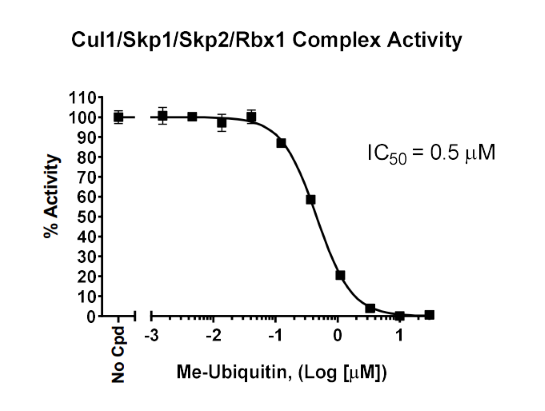CUL1 Intrachain TR-FRET Assay Kit
The CUL1 Intrachain TR-FRET Assay Kit is a homogeneous, sensitive TR-FRET (Time-Resolved Fluorescence Resonance Energy Transfer) assay kit designed to measure CUL1 (cullin 1) auto-ubiquitination. It utilizes a Europium-labeled ubiquitin (Ub) donor as well as Cy5-labeled Ub acceptor to complete the TR-FRET pairing. Since both the TR-FRET donor and acceptor are incorporated into poly-ubiquitin chains formed on CUL1, this assay measures poly-ubiquitination. The kit comes in a convenient 384-well format and contains enough purified CUL1/SKP1/SKP2/RBX1 Complex, purified UBE1 (ubiquitin-like modifier activating enzyme 1), UbcH5b (Ubiquitin-conjugating enzyme E2 D2), Ubi-Mix™, ATP, and assay buffer for 400 reactions.

Figure 1. CUL1 Intrachain TR-FRET Assay Kit schematic.
E1 and E2 enzymes, Europium cryptate-labeled Ubiquitin (TR-FRET donor) and Cy5-labeled Ubiquitin (TR-FRET acceptor) are incubated with CUL1 complex. The donor and acceptor are incorporated into poly-ubiquitin chains formed on CUL1, allowing energy transfer to occur. The TR-FRET signal is proportional to CUL1 activity.
Need us to run inhibitor screens or profile your compounds against CUL1? Check out our Ubiquitination Screening Services.
- Fluorescent microplate reader capable of measuring Time Resolved Fluorescence Resonance Energy Transfer (TR-FRET)
- Adjustable micropipettor and sterile tips
- Orbital Shaker
| Catalog # | Name | Amount | Storage |
| 80301 | UBE1 (UBA1), FLAG-Tag* | 40 µg | -80°C |
| 80314 | UbcH5b, His-Tag* | 60 µg | -80°C |
| 101755 | CUL1/SKP1/SKP2/RBX1 Complex* | 70 µg | -80°C |
| 200x Ubi-Mix™ | 40 µl | -80°C | |
| 4 mM ATP | 2 x 1 ml | -80°C | |
| U2 Assay Buffer | 2 x 10 ml | -80°C | |
| White, nonbinding, low volume microtiter plate | Room Temp |
* The initial concentration of enzyme is lot-specific and will be indicated on the tube containing the protein.
Covalent conjugation to ubiquitin (Ub) is one of the major post-translational modifications that regulates protein stability, function, and localization. Ubiquitination is the concerted action of three enzymes: a Ub-activating enzyme (E1), a Ub-conjugating enzyme (E2), and a Ub ligase (E3). The specificity and efficiency of ubiquitination are largely determined by the E3 enzyme, which directs the last step of the Ub-conjugating cascade by binding to both an E2∼Ub conjugate and a substrate protein. This step ensures the transfer of Ub from E2∼Ub to the substrate, leading to its mono- or poly-ubiquitination.
CUL1, or cullin 1, is part of an E3 ligase complex, the SCF (SKP1 (s-phase kinase associated protein 1)- CUL1- F-box protein) complex, that also involves SKP2 and RBX1 (RING-box protein 1). The SCF complex is involved in the ubiquitination of proteins that act on cell cycle, signal transduction and transcription, with CUL1 serving as a structural scaffold. Cullins can be used in the context of targeted protein degradation in cancer therapy.
Sweeney M., et al., 2020 Scientific Reports 10:13942.


